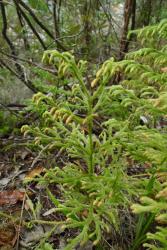- = Lepidotis P.Beauv. ex Mirbel in Lamarck & Mirbel, Hist. Nat. Vég. 3, 477 (1802) nom. rej.
- = Palhinhaea Franco & Vasc. ex Vasc. & Franco, Bol. Soc. Brot. Ser. 2 41: 24 (1967) nom. cons.
- = Lateristachys Holub, Folia Geobot. Phytotax. 18: 441 (1983)
- = Pseudolycopodiella Holub, Folia Geobot. Phytotax. 18: 441 (1983)
- = Brownseya Li Bing Zhang, L.D.Sheph., D.K.Chen, X.M.Zhou & H.HE in Chen et al., Taxon 00: 17 (online) (2021)
Terrestrial plants. Main stems indeterminate, horizontal and creeping or looping, giving rise to determinate, erect, simple or branched, aerial stems, often of different thickness to the horizontal stems. Roots arising at intervals along the length of horizontal stems. Leaves spirally arranged, usually all similar; leaf margins entire or minutely ciliate. Bulbils absent. Sporophylls modified and aggregated into distinct strobili, ephemeral. Strobili terminal on ultimate branches or lateral on overtopping branches, erect or pendent, sessile or stalked. Spores rugulate.
A genus of c. 54 species (PPG 1 2016, including all species in the subfamily Lycopodielloideae).
Following Øllgaard (1987, 1989, 1990) the lycopodioid clade within Lycopodiaceae is interpreted here to include just two genera, Lycopodiella and Lycopodium. However, more recent classifications further subdivide these taxa into four and nine genera, respectively (Field et al. 2016).
The lycopodioid clade is distinguished by anisotomous branching, with dichotomies resulting in branches of unequal thickness; horizontal, indeterminate main stems that are creeping, looping or climbing, and give rise to aerial determinate branches; roots that arise at intervals along the length of the main stem; strongly modified sporophylls aggregated into strobili (Øllgaard 1987, 1990); and reticulate, baculate or rugulate spores (Tryon & Lugardon 1991, figs 229.1–12, 230.1–12; Large & Braggins 1991).
Lycopodiella is distinguished from Lycopodium by its horizontal and subterranean, prostrate or looping stems, strobili that are terminal and either pendent and sessile, or erect on undivided stalks. In some species the strobili are lateral on overtopping branches. Spores are rugulate (Tryon & Lugardon 1991, figs 230.1–12; Large & Braggins 1991). In New Zealand, all species have spirally arranged leaves of one size.
Four species of Lycopodiella (as circumscribed here) are present in New Zealand. In the classification of Field et al. (2016), L. diffusa and L. lateralis would be placed in Lateristachys, L. cernua in Palhinhaea, and L. serpentina in Pseudolycopodiella. New Zealand species of Lycopodiella were included in Lycopodium by Allan (1961).
| 1 | Strobili mostly borne laterally on aerial stems, tan-brown, red-brown or chocolate-brown at maturity | 2 |
| Strobili borne terminally on aerial stems and branches, yellow-brown at maturity | 3 | |
| 2 | Aerial stems prostrate, 25–160 mm long; strobili red-brown or chocolate-brown at maturity | diffusa |
| Aerial stems erect or scrambling upwards, 50–700 mm long; strobili tan-brown at maturity | lateralis | |
| 3 | Horizontal stems looping across the ground; aerial stems branched many times, the ultimate branches curved downwards; strobili pendent or inclined downwards | cernua |
| Horizontal stems prostrate, not looping; aerial stems unbranched, erect; strobili erect | serpentina |
Lycopodiella is a genus of over 50 species occurring in moist temperate and tropical regions. The greatest diversity is in South America; four species in South Africa (Roux 2009), five in Australia (Chinnock 1998). Four indigenous, non-endemic species in New Zealand.
| Category | Number |
|---|---|
| Indigenous (Non-endemic) | 4 |
| Total | 4 |
Chromosome numbers in Lycopodiella are very variable. In sect. Lycopodiella (= Lycopodiella s.str.) most counts are diploid with n = 78; in sect. Caroliniana (= Pseudolycopodiella) n = 34, 35 and c. 69; and in sect. Campylostachys (= Palhinhaea) counts of n = 104, 108, 110, 136, c. 165 have been reported (Øllgaard 1987, 1990).
The type of Lepidotis was first designated by Rothmaler (1944), who chose L. cernua (L.) P.Beauv. That choice was challenged by Pichi Sermolli (1971) who instead designated Lycopodium clavatum L., thereby making Lepidotis a synonym of Lycopodium, a view shared, among others, by Øllgaard (1989, 2012). However, Greuter & Troia (2014) dismissed Pichi Sermolli’s arguments and asserted that Lepidotis is a legitimate name typified by L. cernua, stating that even if Rothmaler’s typification was disregarded, a subsequent typification by Fuchs (1955) could not be rejected. As a consequence, the name Palhinhaea (L.) Franco & Vasc. was made illegitimate because it was based on the previously designated type of Lepidotis. Greuter & Troia therefore proposed the conservation of Palhinhaea against Lepidotis to preserve the use of Palhinhaea and remove the threat to Lycopodiella, a proposal now accepted, leaving Lepidotis a rejected name under Lycopodiella.




